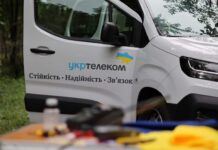In Ukraine, more than 2,000 providers are already using optical communication lines with xPON or GPON technology, and the number of connections to such networks has increased to 46% over the past 1.5 years.
Currently, 3.9 million subscribers use the technology, which provides high speed, power outage and stability of the fixed Internet. This is important not only in most of the territory subject to missile and drone attacks from Russia, but also in the frontline areas that are subject to intense bombardment and rocket attacks.
With automated control systems, optical networks can automatically detect damage and reroute traffic to alternate routes. Most importantly, optical cables offer high bandwidth and resistance to electromagnetic interference.
What are the issues providers are concerned about?
Recently, at a meeting of Internet providers from different regions at the Ministry of Digital Transformation, the main topic was the increase in xPON connections. According to Deputy Prime Minister Mykhailo Fedorov, the technology provides 72 hours of home Internet access during power outages, which is very important in the context of Russia’s constant shelling.
“We have to do everything possible to get as many people as possible connected to the technology, and to become the best in the world in terms of speed and number of xPON connections,” Fedorov said.
The Ministry of Digital Transformation will motivate providers and Ukrainians to switch to this technology starting in 2022.
Market representatives discussed the issues that prevent providers from connecting xPON quickly, especially in front-line areas.
These are the issues they are most concerned about today:
- Improve the ability to book emergency crews to restore the Internet upon arrival.
- Government support and international investment to help providers connect and scale xPON in Ukraine faster.
- Extension of the Internet subsidy, which will help to increase the number of settlements with optical Internet access.
- Work on the Diia service, which will allow Ukrainians to see the nearest xPON providers, the price and the connection time.
The official believes that providers should connect to xPON as quickly as possible at an affordable price.
xPON performance results
During recent large-scale blackouts, optical networks have proven their resilience, even in areas under constant shelling. For example, during the last blackout, 100% of xPON users and only 27% of FTTB users had Internet access after 8 hours.
At the same time, after the shelling, 90% of subscribers who connected to xPON had stable Internet access.
By the way, most providers in their reports talk about the expansion of GPON networks, while the Ministry of Digital Transformation talks about xPON. But there is no contradiction. GPON stands for Gigabit Passive Optical Network. And xPON is a variety of passive optical networks, including advanced versions of GPON that offer speeds of up to 10 Gbps per

Frontline Internet
Today, Ukrtelecom is the largest operator laying optics in the frontline areas. The company recommends connecting to GPON and declares that the new network is ready to work up to 96 hours after a power outage.
According to the latest data obtained by HiTech Expert from the company, in the Eastern macro-region, which includes Chernihiv, Sumy, Poltava and Kharkiv regions, 1155 kilometers of optical lines have been laid, and in 2024 a total of 106 thousand households can be connected to the energy-independent Internet.
Ukrtelecom’s Internet is currently available in 646 settlements of the macro region, 381 of which already have a network based on GPON technology. Here is the breakdown by regions:
- Chernihiv – more than 475 km, 116 settlements with GPON;
- Sumy – more than 180 km, 58 settlements;
- Kharkiv – 270 km, 103 settlements;
- Poltava – over 230 km, 104 settlements.
“We are making significant progress in connecting subscribers to optical networks, which is a real challenge in times of war. In 2024, Ukrtelecom has already connected more than 9 thousand subscribers to its optical network. The volume of construction of new optical lines is also one of the largest, considering that three out of four of our branches are located in the border areas, right next to the aggressor,” says Andriy Pustovoitenko, Head of Ukrtelecom’s Eastern Macro Region.
It is also worth mentioning the example of the Zaporizhzhya region, where the authorities are encouraging providers to connect subscribers using new technologies free of charge.
“Currently, almost all terrestrial operators in the Zaporizhzhya region are connecting xPON technology free of charge. Therefore, I urge all residents of the region who have such an opportunity to take advantage of this feature,” said Volodymyr Cherednichenko, Deputy Head of the Zaporizhzhya Region State Administration for Digital Development, Digital Transformation and Digitalization.











